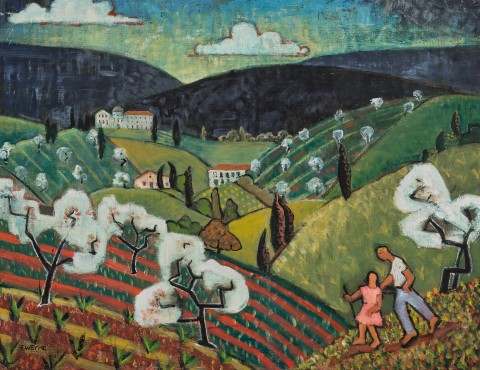TUSCAN LANDSCAPE (VERSO: SIENA), c.1930
EVELINE SYME
oil on canvas
52.0 x 66.5 cm
signed lower left: E. W SYME
The Estate of the Artist, Melbourne
Jim Alexander Gallery, Melbourne
Joseph Brown Gallery, Melbourne, acquired from the above in 1991
The Cbus Collection of Australian Art, Melbourne, acquired from the above on 27 February 1991
Morning, Noon and Night, Latrobe Regional Gallery, Victoria, 13 July - 13 October 2019
on long term loan to Latrobe Regional Gallery, Victoria
Nainby, B., Stanhope, Z., and Furlonger, K., The Cbus Collection of Australian Art, in association with Latrobe Regional Gallery, Melbourne, 2009, pp. 15, 48 (illus.), 232 (as ‘Landscape and orchard’)
Tuscan Landscape, c. 1930, oil on canvas, in the collection of University College, University of Melbourne, Melbourne
Well-heeled, well-travelled and well connected to influential members of avant-garde art in London and Paris, Australian artist Eveline Syme held a key position in the development and dissemination of Modernist art in the Antipodes. Alongside her life-long friend and artistic peer Ethel Spowers, Syme travelled to Europe to broaden and continue her education. In 1922 they studied at La Grande Chaumière in Paris under Symbolist painter Maurice Denis, followed by a period of at the Grosvenor School of Art led by eccentric British printmaker Claude Flight and finally, Syme alone returned to studies in Paris October 1929 at the school of Cubist French painters André Lhote and Albert Gleizes. While Spowers came home to Melbourne in the winter of 1929, Eveline Syme travelled on alone through Italy and Belgium, before returning herself in April 1930.
Having read Classics at Cambridge and most likely been exposed to Cyril Power’s medieval modernist illustrations, Eveline Syme had an interest in classical architecture and appreciation for history that is reflected in the works that she created during her travels.1 Staying for a brief period in the medieval Italian town of Siena, Syme found a significant source of artistic inspiration in its architecture and the rolling Tuscan hills of the surrounding countryside. In addition to several watercolours and oil paintings, Syme produced six linocuts of various Tuscan scenes, examples of which are held in many state and national galleries. Tuscan Landscape, c.1930 is an exceptional double-sided painting, with striking similarities to the compositions of key linocuts: The Outskirts of Siena, 1930 – 31 and The Lily Tower, Siena, 1930. The Sienese cityscape verso bears the narrow vertical composition and restricted four-tone colour palette that would form the basis of The Lily Tower.
Within this highly stylised pastoral scene, Syme has created in Tuscan Landscape an energetic and modern aesthetic by incorporating elements from her Symbolist, Cubist and Futurist studies. Like her Grosvenor School peer, Adelaidean Dorrit Black, Syme was very receptive to Lhote’s insistence on traditional geometry founded on the section d’or and Jay Hambidge’s system of dynamic symmetry, which was similarly based on classical ratios. Tuscan Landscape is carefully constructed according to the golden points of a rectangle, in which the centre of the picture contains the most concentrated area of patterning. The alternating cadence of tiered diagonal hills, brightly patterned and dotted with flowering fruit trees, endows the idyllic scene with a decorative rhythm. Syme has merged the elements of the pastoral landscape into imbricated planes and populated her scene with jagged forms heavily outlined. The sky above has radiating bands of colour painted with the square end of the brush (a technique also used by Roy de Maistre and Grace Cossington Smith) and is overlaid with whimsical flat-bottomed billowing clouds, which also feature in Syme’s linocuts of the same period. Dorrit Black, Ethel Spowers, and Eveline Syme, shared a social standing and affluence that enabled them to travel abroad to, as scholar and curator Tracey Lock aptly qualified, ‘cultivate their commitment to what was then a radical aesthetic in Australian Art’.2
1. Samuel, G. (ed.), Cutting Edge. Modernist British Printmaking, Bloomsbury, London, 2019, p.50 and Coppel, S., 'Syme, Eveline Winifred (1888–1961)', Australian Dictionary of Biography, Australian National University, https://adb.anu.edu.au/biography/syme-eveline-winifred-11814/text21139, accessed online 2 June 2022
2. Lock, T., cited in Samuel G., ibid, p. 68
LUCIE REEVES-SMITH
